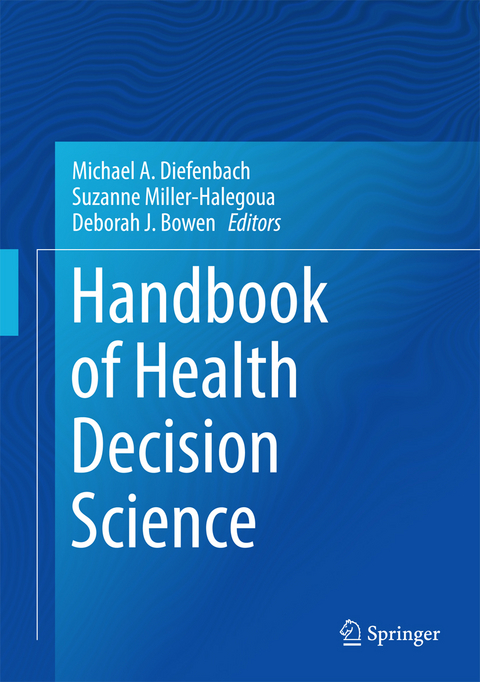
Handbook of Health Decision Science
Springer-Verlag New York Inc.
978-1-4939-7439-9 (ISBN)
Among the Handbook’s topics:
From laboratory to clinic and back: connecting neuroeconomic and clinical mea
sures of decision-making dysfunctions. Strategies to promote the maintenance of behavior change: moving from theoretical principles to practices.
Shared decision making and the patient-provider relationship.
Overcoming the many pitfalls of communicating risk.
Evidence-based medicine and decision-making policy.
The internet, social media, and health decision making.
The Handbook of Health Decision Science will interest a wide span of professionals, among them health and clinical psychologists, behavioral researchers, health policymakers, and sociologists.
Michael A. Diefenbach, Ph.D., is a professor of Medicine, Urology and Psychiatry at Northwell Health and the Hofstra Northwell School of Medicine at Hofstra University. He is a social/health psychologist and the director of the behavioral research program at the Departments of Medicine and Urology at Northwell Health. t-family: Helvetica, sans-serif;">Suzanne M. Miller, Ph.D. is a Senior Member at Fox Chase Cancer Center, where she is Director of the Behavioral Medicine Program, the Behavioral Research Core Facility, and the Behavioral Center of Excellence in Breast Cancer. As a clinical/health psychologist, Dr. Miller has been interested in the interface of psychology and medicine, extending basic constructs in cognitive and social science to the domain of behavioral oncology. Her funded research – through the National Cancer Institute, the American Cancer Society, and the Department of Defense -- centers on the cognitive-affective processing of threatening health information and the implications for the design and assessment of interventions to facilitate decision making, adjustment, and adherence, with a special focus on genetic conditions, special populations, and individual family development. Deborah J. Bowen, Ph.D., is a professor in the Department of Community Health Sciences at Boston University School of Public Health. She is also an adjunct full member at the Fred Hutchinson Cancer Research Center and was the head of the Social/Behavioral Sciences Affinity Group, within the Cancer Prevention Research Program. Her research interests include both community and individual interventions to prevent cancer and cancer mortality.
Introduction.- Part I. Basics first.- 1. What are utilities, preferences and values?.- 2. Heuristics and decision making.- 3. Modeling and mathematical models of decision making.- Part II. Decision making on the individual level.- 4. Basic science articles from the judgment and decision literature.- 5. Basic science article from the health psychological/self-regulation perspective.- 6.Decision making for single events.- 7.Maintaining decision making for multiple events.- 8.Decision making in aging populations: time horizons and familial influences.- 9.Decision making in young adults.- 10. Decision making in disadvantaged populations. Part III. Decision making on the interpersonal level.- 11. Basic science article of spouses/partners and family members.- 12. Decisional influences of health care providers.- Part IV. Decision making by health care providers.- 13. Models of shared decision making.- 14. End-of-life decision making.- 15.&nbs
p; Legal aspects of decision making for health care providers.- Part V. Applied decision making.- 16. Decision tools in shared decision making for patients.- 17. Decision tools for health care professionals.- 18. Integration of decision tools in the health care environment: The example of Kaiser Permanente.- 19. The VA as an example of an integration decision tools for patients and physicians.- Part VI. The communication of decisions.- 20. Graphical and numerical communication.- 21. Health literacy and numeracy.- Part VII. Decision making on the organizational level.- 22. Decision making using Electronic Medical records.- 23. Decision making on the practice level.- Part VIII. Decision making on the state and national health policy environment.- 24. How health policy gets made.- 25. Recent changes in the health care environment.- Part IX. The future of decision making.- 26. The promise of New Media: savior or curse?- 27. Social networks and the power of many.- 28. Decision making in the age of genome wide sequencing.
| Erscheinungsdatum | 25.07.2017 |
|---|---|
| Zusatzinfo | 30 Illustrations, black and white; XIV, 377 p. 30 illus. |
| Verlagsort | New York |
| Sprache | englisch |
| Maße | 178 x 254 mm |
| Themenwelt | Geisteswissenschaften ► Psychologie ► Psychoanalyse / Tiefenpsychologie |
| Geisteswissenschaften ► Psychologie ► Sozialpsychologie | |
| Medizin / Pharmazie ► Medizinische Fachgebiete ► Medizinethik | |
| Medizin / Pharmazie ► Medizinische Fachgebiete ► Psychiatrie / Psychotherapie | |
| Medizin / Pharmazie ► Pflege | |
| Studium ► Querschnittsbereiche ► Prävention / Gesundheitsförderung | |
| Schlagworte | Cancer decision making • Cancer prevention and control • clinical decision making • Decision heuristics • Decision research • decision science • End-of-life Decisions • Health Care Policy • Health decision making • Shared Decision Making • Treatment decision making |
| ISBN-10 | 1-4939-7439-4 / 1493974394 |
| ISBN-13 | 978-1-4939-7439-9 / 9781493974399 |
| Zustand | Neuware |
| Haben Sie eine Frage zum Produkt? |
aus dem Bereich


